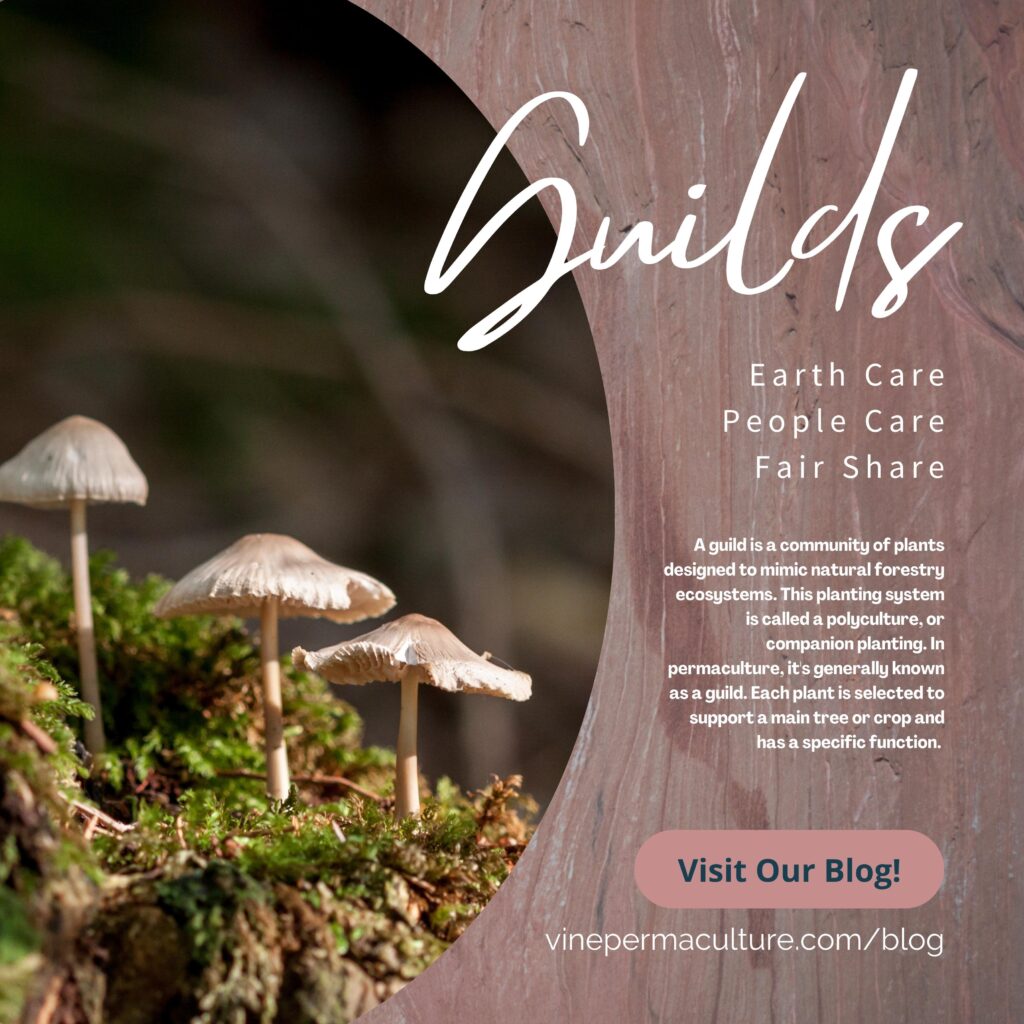What is a guild?
A guild is a community of plants designed to mimic natural forestry ecosystems. This planting system is called a polyculture, or companion planting. In permaculture, it’s generally known as a guild. Each plant is selected to support a main tree or crop and has a specific function.
There Are 6 core functions which make up a guild, these include:
– Pollinator Plants
– Repellants
– Suppressors
– Mulch makers
– Accumulators
– Nitrogen fixers

Pollinator Plants
Full post here
These plants attract beneficial pollinator insects to your garden. Do your research and find out what pollinators are common, and then choose native plants they’re attracted to. For example, plant milkweed to attract monarchs or sunflowers to attract ladybugs. Also, make sure to choose plants that will bloom at the same time as your fruit trees. By keeping these in sync you may experience higher yields.
Repellants
Repellant plants are usually very fragrant and used to confuse pests. Plant these by trees you know are susceptible to particular pest issues. Dill, cilantro, nasturtium, sage, and basil are great examples of repellant plants. Sometimes these plants repel bad bugs, but attract good ones too! For example; planting dill may repel pests but it can also attract insects such as lacewings and predatory wasps. These predatory insects destroy soft-bodied pests like aphids and caterpillars!
Suppressors
These plants are used to suppress grass and weeds which might compete for plant nutrients. Bulbs are usually a shallow root system, making them ideal for this purpose. But some suppressors are plants with dense leaves, such as pumpkins or strawberries which heavily shade and protect the soil. These reduce competitor plant growth while making the best use of productive space!
Mulch Makers
These are low-maintenance, perennial plants that are frequently used for chop-n-drop. These will come back year after year, and provide lots of leaves for quick mulch around the guild beds. They add biomass, regenerate quickly, and usually offer food or medicinal benefits too. Artichokes, comfrey, and rhubarb are classic examples.
Accumulators
Full post here
These are generally plants with a taproot. The root loosens up compacted soil, improving water and oxygen exchange while extracting nutrients from deeper soil layers. This brings valuable resources closer to the surface making them more available to surrounding plants. An accumulator is also a plant that ‘accumulates’ the nutrients in the stem and leaves. This has pros and cons. On one hand, they make excellent choices for chop-and-drop due to increased fertilization. On the other hand, they tend to accumulate toxins or heavy metals under the right conditions too. Many accumulator plants are being tested for phytoremediation because of this (very much a ’problem is the solution’ approach though!). Comfrey is perhaps the classic example of an accumulator that is also a mulch maker for chop and drop.
Nitrogen Fixers
These plants convert nitrogen in the air into a usable plant form. The nitrogen is stored in root nodules, improving the soil around it. You could say that these plants are natural fertilizers! Geoff Lawton teaches a method of coppicing that accelerates the nitrogen-fixing function. When the plant is pruned above ground, the plant prunes its root system below ground. This is because the plant doesn’t need as many roots to support the reduced canopy size. The nitrogen nodules will remain active in the soil and as the plant re-grows it produces more! Rinse and repeat! The natural cycle of nitrogen fixation got boosted! This is a great method used in pioneer species and for improving poor soils.
What if you only have limited space for planting a guild though? No worries. Stack those functions! As mentioned before, some of these plants perform more than one job. Comfrey is a great example of this. It is an accumulator, mulch maker, pollinator, and repellant. It is also said to be chicken feed and medicinal! So if space is limited, look for plants that serve multiple functions so you don’t need to plant so many varieties.
There are many guild options, provided you understand your grow zone and microclimate. If you want to build your own guilds, make sure to include these 6 core functions to support your main tree or food crop! We have provided you with some examples to get you started. You can also follow our Facebook & Instagram for regular and downloadable guild diagrams.



